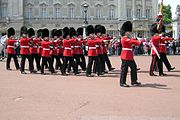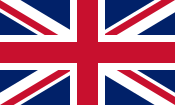[edit] Administrative
Divisions administrating all military units, both Regular and TA, within a geographical area (e.g. 5 Div based in
Shrewsbury).
[edit] Operational
The three major commands are
Land Command, Headquarters
Adjutant General, and Headquarters Northern Ireland.
Corps made up of two or more Divisions (now unlikely to be deployed as a purely national formation due to the size of the British Army) e.g. the
ARRC.
Division made up of two or three Brigades with an HQ element and support troops. Commanded by a
Major-general.
Brigade made up of between three and five Battalions, an HQ element and associated support troops. Commanded by a
Brigadier.
Battlegroup. This is a mixed formation of armour, infantry, artillery, engineers and support units, and its structure is task specific. It is formed around the core of either an Armoured Regiment or Infantry Battalion, and has other units added or removed from it as necessary. A Battlegroup will typically consist of between 600 and 700 soldiers under the command of a Lieutenant Colonel.
Company of about 100 soldiers, typically in three platoons, commanded by a
Major.
[edit] Aviation components
[edit] Special forces
The British Army contributes two of the three
special forces formations within the
United Kingdom Special Forces Command; the
Special Air Service Regiment and the
Special Reconnaissance Regiment.
The most famous formation is the
Special Air Service Regiment. Formed in 1941, the SAS is considered the role model for many other
special forces units in the world.
[13]
The SAS comprises one regular Regiment and two
Territorial Army Regiments and is headquartered at Duke of York Barracks,
London.
The regular Regiment, 22 SAS Regiment has its headquarters and depot located in
Hereford and consists of five squadrons: A, B, D, G and Reserve and a training wing. The regiment has battlespace roles in deep reconnaissance, target identification and indication and target destruction and denial. In its Counter Terrorism role it is seen as one of the prime anti-terrorist, hostage rescue and target capture units in the world.[
citation needed]
The two reserve SAS Regiments;
21 SAS Regiment and
23 SAS Regiment have a more limited role,to provide depth to the
UKSF group through the provision of Individual and collective augmentation to the regular component of UKSF and standalone elements up to task group (Regimental) level focused on support and influence (S&I) operations to assist conflict stabilisation.
[14]
The
Special Reconnaissance Regiment (SRR) which was formed in 2005, from existing assets, undertakes close reconnaissance and special surveillance tasks.
[15]
Formed around 1st Battalion the
Parachute Regiment, with attached
Royal Marines and
RAF Regiment assets, the
Special Forces Support Group are under the Operational Control of Director Special Forces to provide operational manoeuvre support to the elements of United Kingdom Special Forces.
[edit] Recruitment
The Army mainly recruits within the United Kingdom, and normally has a recruitment target of around 25,000 soldiers per year.
Low unemployment in Britain has resulted in the Army having difficulty in meeting its target , and in the early years of the 21st century there has been a marked increase in the number of recruits from other (mostly
Commonwealth) countries. In 2008
Commonwealth origin volunteers comprised approximately 6.7% of the Army's total strength. In total 6,600 foreign soldiers from 42 countries were represented in the Army, not including
Gurkhas. After Gurkhas, the nation with most citizens in the British Army is
Fiji, with 1,900, followed by
Jamaica and
Ghana with 600 each; many soldiers also come from more prosperous countries such as
New Zealand,
South Africa and the
Republic of Ireland.
The
Ministry of Defence is now considering capping the number of recruits from Commonwealth countries, although this will not affect the Gurkhas. If the trend continues 10% of the army will be from Commonwealth countries before 2012. The cap is being debated, as some fear the army's "
Britishness" is being diluted, and employing too many could make the army seen as employing "
mercenaries".
[16]
The minimum recruitment age is 16 years (but only after the end of GCSEs), although soldiers may not serve on operations below 18 years; the maximum recruitment age was raised in January 2007 from 26 to 33 years. The normal term of engagement is 22 years, and once enlisted soldiers are not normally permitted to leave until they have served at least 4 years.
[17]
There has been a strong and continuing tradition of recruiting from Ireland including what is now the
Republic of Ireland. Almost 150,000 Irish soldiers fought in the First World War; 49,000 died. More than 60,000 Irishmen, more than from
Northern Ireland, also saw action in the Second World War; like their compatriots in the Great War, all were volunteers. There were more than 400 men serving from the Republic in 2003.
[18]


Troops of the
Grenadier Guards on guard at
Buckingham Palace. Various army regiments supply troops to guard the Royal residences.
All soldiers must take an oath of allegiance upon joining the Army, a process known as "attestation". Those who believe in
God use the following words:
“I (state your name), swear by Almighty God that I will be faithful and bear true allegiance to
Her Majesty Queen Elizabeth II, her heirs and successors and that I will as in duty bound honestly and faithfully defend Her Majesty, her heirs and successors in person,
crown and dignity against all enemies and will observe and obey all orders of Her Majesty, her heirs and successors and of the generals and officers set over me.
[19]”
Others replace the words "swear by Almighty God" with "solemnly, sincerely and truly declare and affirm."
[20]
ITC Catterick
Infantry Battle School, Brecon
Support Weapons School, Warminster
[edit] Flags and ensigns



Flag Ratio: 3:5. The official flag of the Army.


The non-ceremonial flag of the British Army. Sometimes the word "Army" in gold letters appears below the badge.
The British Army does not have its own specific ensign, unlike the Royal Navy, which uses the
White Ensign, and the RAF, which uses the
Royal Air Force Ensign. Instead, the Army has different flags and ensigns, for the entire army and the different regiments and corps. The official flag of the Army as a whole is the
Union Flag, flown in ratio 3:5. A non-ceremonial flag also exists, which is used at recruiting events, military events and exhibitions. It also flies from the MOD building in Whitehall.
[21] Whilst at war, the Union Flag is always used, and this flag represents the Army on the
Cenotaph in
Whitehall,
London (the UK's memorial to war dead). A British Army ensign also exists for vessels commanded by a commissioned officer, the
Blue Ensign defaced with the Army badge. Army Vessels are operated by the Maritime element of the
Royal Logistic Corps.
Each line regiment (which does not include the Rifle Regiments) also has its own flags, known as
the Colours - the Regimental Colour and the Queen's Colour. These Colours have been taken into battle in the past and give pride to the regiment. There is great variation in the designs of different Regimental Colours. Typically the colour has the Regiment's badge in the centre.